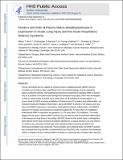| dc.contributor.author | Gautam, Shiva | |
| dc.contributor.author | Talmor, Daniel S. | |
| dc.contributor.author | Gallagher, Diana C. | |
| dc.contributor.author | Barrett, Christopher D | |
| dc.contributor.author | Debusk, Michael George | |
| dc.contributor.author | Yaffe, Michael B | |
| dc.contributor.author | Hsu, Albert | |
| dc.contributor.author | Ellson, Chris | |
| dc.date.accessioned | 2016-12-19T16:43:36Z | |
| dc.date.available | 2016-12-19T16:43:36Z | |
| dc.date.issued | 2015-08 | |
| dc.identifier.issn | 1073-2322 | |
| dc.identifier.uri | http://hdl.handle.net/1721.1/105873 | |
| dc.description.abstract | Primed neutrophils that are capable of releasing matrix metalloproteinases (MMPs) into the circulation are thought to play a significant role in the pathophysiology of acute respiratory distress syndrome (ARDS). We hypothesized that direct measurement of plasma MMP-9 activity may be a predictor of incipient tissue damage and subsequent lung injury, which was investigated in both an animal model of ARDS and a small cohort of 38 critically ill human patients. In a mouse model of ARDS involving instillation of intratracheal lipopolysaccharide (LPS) to induce lung inflammation, we measured neutrophil-mediated inflammation, along with MMP-9 activity in the airways and lung tissue and MMP-9 expression in the plasma. Neutrophil recruitment, inflammation, and MMP-9 activity in the airways and lung tissue increased throughout the 72 h after LPS instillation, whereas plasma MMP-9 expression was greatest at 12 to 24 h after LPS instillation. The results suggest that the peak in plasma MMP-9 activity may precede the peak of neutrophil inflammation in the airways and lung tissue in the setting of ARDS. Based on this animal study, a retrospective observational cohort study involving 38 patients admitted to a surgical intensive care unit at a tertiary care university hospital with acute respiratory failure requiring intubation and mechanical ventilation was conducted. Plasma samples were collected daily, and MMP-9 activity was compared with lung function as determined by the PaO[subscript 2]/FiO[subscript 2] ratio. In patients who developed ARDS, a notable increase in plasma MMP-9 activity on a particular day correlated with a decrease in the PaO[subscript 2]/FiO[subscript 2] ratio on the following day (r = -0.503, P < 0.006). Taken together, these results suggest that plasma MMP-9 activity changes, as a surrogate for primed neutrophils may have predictive value for the development of ARDS in a selected subset of critically ill patients. | en_US |
| dc.description.sponsorship | National Institutes of Health (U.S.) (Grants R01-GM59281, P50-GM68762 and UM1-HL120877) | en_US |
| dc.description.sponsorship | National Institutes of Health (U.S.) (Ruth L. Kirschstein National Research Service Award) | en_US |
| dc.language.iso | en_US | |
| dc.publisher | Ovid Technologies (Wolters Kluwer) - Lippincott Williams & Wilkins | en_US |
| dc.relation.isversionof | http://dx.doi.org/10.1097/shk.0000000000000386 | en_US |
| dc.rights | Creative Commons Attribution-Noncommercial-Share Alike | en_US |
| dc.rights.uri | http://creativecommons.org/licenses/by-nc-sa/4.0/ | en_US |
| dc.source | PMC | en_US |
| dc.title | Kinetics and Role of Plasma Matrix Metalloproteinase-9 Expression in Acute Lung Injury and the Acute Respiratory Distress Syndrome | en_US |
| dc.type | Article | en_US |
| dc.identifier.citation | Hsu, Albert T. et al. “Kinetics and Role of Plasma Matrix Metalloproteinase-9 Expression in Acute Lung Injury and the Acute Respiratory Distress Syndrome:” Shock 44.2 (2015): 128–136. | en_US |
| dc.contributor.department | Massachusetts Institute of Technology. Department of Biological Engineering | en_US |
| dc.contributor.department | Massachusetts Institute of Technology. Department of Biology | en_US |
| dc.contributor.department | Koch Institute for Integrative Cancer Research at MIT | en_US |
| dc.contributor.mitauthor | Barrett, Christopher D | |
| dc.contributor.mitauthor | Debusk, Michael George | |
| dc.contributor.mitauthor | Ellson, Christian | |
| dc.contributor.mitauthor | Yaffe, Michael B | |
| dc.contributor.mitauthor | Hsu, Albert | |
| dc.relation.journal | Shock | en_US |
| dc.eprint.version | Author's final manuscript | en_US |
| dc.type.uri | http://purl.org/eprint/type/JournalArticle | en_US |
| eprint.status | http://purl.org/eprint/status/PeerReviewed | en_US |
| dspace.orderedauthors | Hsu, Albert T.; Barrett, Christopher D.; DeBusk, George M.; Ellson, Christian D.; Gautam, Shiva; Talmor, Daniel S.; Gallagher, Diana C.; Yaffe, Michael B. | en_US |
| dspace.embargo.terms | N | en_US |
| dc.identifier.orcid | https://orcid.org/0000-0001-9720-8155 | |
| dc.identifier.orcid | https://orcid.org/0000-0002-9547-3251 | |
| mit.license | OPEN_ACCESS_POLICY | en_US |
